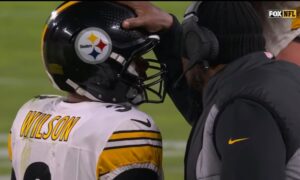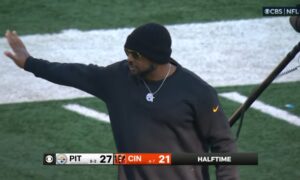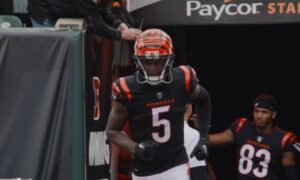The average Steelers fan knows that the Pittsburgh Steelers did not get their current name until 1940. Before that, many know that the franchise was named the Pittsburgh Pirates from 1933-1939. What most Steelers fans do not know is that the Black & Gold had a third official name: The Iron Men.
BLACK SABBATH FLASHBACKS
No, I am not having Black Sabbath flashbacks. This story goes back to the byzantine relationship between the Pittsburgh Steelers and the Philadelphia Eagles. I’ll try to unlock this “riddle, wrapped in a mystery, inside an enigma” for you. The key is ownership.
The Eagles and the Steelers entered the league the very same year: 1933. Both teams were pathetic in the 1930’s. The Eagles best division finish was third out of five teams in 1934. That year they finished with four wins and seven losses. The birds had a better record in 1938 with five wins and six losses. But finished in fourth place. In seven seasons from 1933-1939; the Eagles had a combined 18-55-3 record. A full third of their victories against Pittsburgh.
WOEFUL TEAMS
Pittsburgh had a slightly better record; coming in second place in 1936 just missing a berth in the championship game by losing the last game of the season. Pittsburgh had a 22-55-3 record from 1933-1939. They beat the Eagles in seven of 13 games played. Both teams finished last in the NFL’s East Division three times – clearly the doormats of the east.
Art Rooney had entered Pittsburgh into the NFL in 1933 by paying a $2500 franchise fee. Bert Bell entered the same year with Philadelphia as a co-owner. He became the full owner and head coach in 1936 by buying out his partners with a $4500 bid at public auction. Both teams were not only losers; they were broke. Rooney estimated that he lost over $100,000 in his first seven years of operation. The Eagles used up $85,000 from 1933-1935 leading to the auction that gave Bell full ownership.
START OF A NEW DECADE
1940 was the start of a new decade and emergence from the Great Depression that had hampered the economy for a decade. There was also war on the horizon with Japan already occupying large parts of China and Germany had invaded Poland and annexed the Sudetenland of Czechoslovakia and Austria. The US of A was not at war yet, but many knew it was just a matter of time. Former rookie whiz kid, Whizzer White had left Pittsburgh after the 1938 season to obtain his Rhodes Scholarship in England but had returned to America due to the outbreak of hostilities – he would become a Detroit Lion and play against Pittsburgh in 1940.
STEELERS STEAL PIRATES NAME
In Pittsburgh, 1940 began with a much more serene contest. Rooney decided to change the name of the team, in part, to avoid confusion with the more established professional baseball team, the Pittsburgh Pirates. A committee was formed and more than 3000 suggestions on a new name for the team were received. On March 3, 1940 the Pittsburgh Press reported that the new name selected was the Pittsburgh Steelers. Former Pittsburgh head coach Joe Bach chaired the committee. Arnold Goldberg of the Uniontown Daily News Standard was credited with the first entry received with “Steelers” being one of the suggestions he listed. In fact, 20 other entries also had Steelers and all 21 winners were to receive two season tickets for 1940 season costing Rooney about $200 apiece.
Rooney had high hopes for the 1940 season with Walt Kiesling set to be the head coach for his first full season. Jack Sell of the Pittsburgh Post-Gazette wrote in August 1940, “From President Art Rooney down to the second assistant water boy, the hope prevails that dropping overboard of the old of Pirates will find misfortunes of the past few seasons sinking out of sight as well.”
WAR IN EUROPE
However, the war in Europe was a burgeoning backdrop as the country strove to keep some normalcy. In September 1940, President Roosevelt signed the Selective Training and Service Act into law. Military conscription was now inevitable and likely to gouge the ranks of NFL rosters. Injuries derailed the Steelers 1940 campaign. At least twelve players on the 33-man roster were hospitalized during the season including three broken ankles and a fractured skull. A season that had begun with optimism and a new identity had ended disastrously with a 2-7-2 record and a fourth place finish in the East Division just ahead of the Eagles whose only win that season was against Pittsburgh in the Steeler’s final game of the season.
There were some rumors during the season that Art Rooney might have reached his limit. Despite the lackluster season, the Chief did manage to turn a profit with his football team. Alas, it was a paltry $5000 in the black. Hardly enough to offset the tens of thousands of dollars lost in the earlier seasons. Bert Bell was in a similar position; Philadelphians were not going to support a losing team. The days of huge television contracts, revenue sharing and massive public subsidies for stadia were decades away. NFL owners relied primarily on gate receipts to keep their franchises solvent.
RUMOR CONTROL
In 1940, Pittsburgh was the tenth largest city in the nation with a population of 671,659 – more than double the 2010 census population of 305,704. Boston was the ninth largest city and had just lost its franchise. Brash team founder George Preston Marshall had abandoned the city and moved the Redskins to Washington since his team just could not attract enough crowds in Beantown. Yet, here was an east coast town that had a large population base. As early as April 10, 1940 the newspapers reported that Rooney ‘quashed’ rumors of the Steelers moving to Boston “with a firm determination to continue at Forbes Field and turn out a winner for the local fandom.”
ROONEY SELLS STEELERS
On November 12, 1940 Art Rooney announced that Walt Kiesling would return as coach in 1941. But then on December 10, 1940 the bombshell hit. “Rooney Sells Steelers” the sports headline begins. What happened?
Enter a new character tied to Pittsburgh Steelers lore: Alexis Thompson. He was the grandson of the founder of Republic Iron & Steel. Ironically, the same Republic Steel whose employee first suggested that the Steelers adopt the steel industries logo in 1962. In 1929 Thompson inherited $6 million when his father died. He was just 15 years old. In 1940, Thompson was a 26-year-old entrepreneur looking to buy an NFL franchise. Both the Eagles and Steelers were losing franchises with vulnerable financial positions. Ripe for picking and moving to Boston which had a vacancy.
Rooney and Thompson met at least twice in October 1940. First on October 13th in New York when the Steelers played the Giants and then the following week when Pittsburgh played the Green Bay Packers near Milwaukee. It must have seemed appealing as the Steelers were in a six-game losing streak. No deal was struck. According to Art Rooney in contemporary newspaper articles, Thompson then began negotiating for the Eagles.
SECRET MEETINGS SET UP A DEAL
A set of secret meetings were held in the first week of December that included Thompson, Rooney, Walt Kiesling and Eagles coach Heinie Miller. One of the early rumored configurations of the deal described by Havey Boyle, Pittsburgh Post-Gazette sports editor, was for Thompson to buy the Steelers and move the franchise to Boston. Bell and Rooney would then become partners in a joint Pennsylvania club called the Keystoners that would split home games between Pittsburgh and Philadelphia. Thankfully, that proposal did not come to fruition.
What did happen is that 26-year-old Thompson bought the Steelers lock, stock & barrel from Art Rooney for the sum of $160,000. Art Rooney was no longer the owner of the Pittsburgh Steelers. In one transaction Rooney recouped all his losses from the first eight years, plus a tidy profit. As the new owner of the Steelers, Thompson committed to keeping the team in Pittsburgh… at least one more year. He hired Greasy Neale to coach the Steelers and advised that he and his New York-based staff would relocate to Pittsburgh on March 1, 1941. In the meantime, he would be a commuting owner.
ROONEY AND BELL PARTNERS
The next part of the deal had Art Rooney taking half of the money from the purchase and buying 50% of the Eagles. The transaction made the Chief and Bert Bell co-owners of the Philadelphia franchise. I did not figure out whether one or the other had controlling interest. Rooney’s business manager of the Steelers Joe Carr and Kielsing were to move to Philadelphia to help run the team. Kiesling was to be an assistant coach with Heinie Miller. Meanwhile, Bert Bell searched for a “name” head coach. Pete Cawthon from Texas Tech was often mentioned as the possible name but that never happened.
A third part of the deal was figuring out who was going to play where. The Steelers and Eagles players were divided up between the two teams with 17 players from the Steelers 1940 roster to stay in Pittsburgh while 11 went to Philadelphia.
STEELERS RENAMED IRON MEN
On January 16, 1941 Pittsburgh’s professional football team received its third name in as many seasons. While attending the NFL coaches meeting in Chicago, Alexis Thompson announced that he had rechristened his team and that henceforth they were Pittsburgh Iron Men. The Pittsburgh Steelers were no more.
But the story does not end there. On April 3rd, 1941 just, a few days after April Fool’s Day, it was announced that a swap would take place. The Philadelphia Eagles would be coming to Pittsburgh with co-owners Art Rooney & Bert Bell. While Alexis Thompson would take the Pittsburgh Iron Men to the city of brotherly love. Thompson never did relocate to Pittsburgh and it appears he preferred Philadelphia’s proximity to his other business interests in New York. And Art Rooney may have been suffering some ownership withdrawal symptoms.
FORMER STEELERS AND EAGLES SWAP CITIES
Under the new scheme co-owner Bert Bell was to be head coach with Walt Kiesling his assistant. Heine Miller declined to move to Pittsburgh since he could not afford to leave his insurance business in Philadelphia. Art Rooney was without a football team in Pittsburgh for less than four months. The Pittsburgh Iron Men were existent for less than 90 days and now resided in Philadelphia. Nonetheless, it is another piece of Pittsburgh Steelers history.
Alexis Thompson former owner of the then Steelers, now Iron Men, would remain the Eagles owner until January 1949. He sold the team for $250,000 just a few weeks after winning the 1948 NFL championship. A year earlier his Eagles were NFL runner-up after defeating Pittsburgh in a 1947 playoff game to represent the East Division. He died in 1954 at just 40 years of age.
YOUR MUSIC SELECTION
In the 2018 Memorial Day Weekend: Steelers Friday Night Five Questions, I committed to play songs that Steelers Depot respondents had suggested might be the new Steelers anthem if Renegade by Styx was ever replaced. Here is entry four of 45 from Jeremy: We’re Not Gonna Take It by Twisted Sister.








